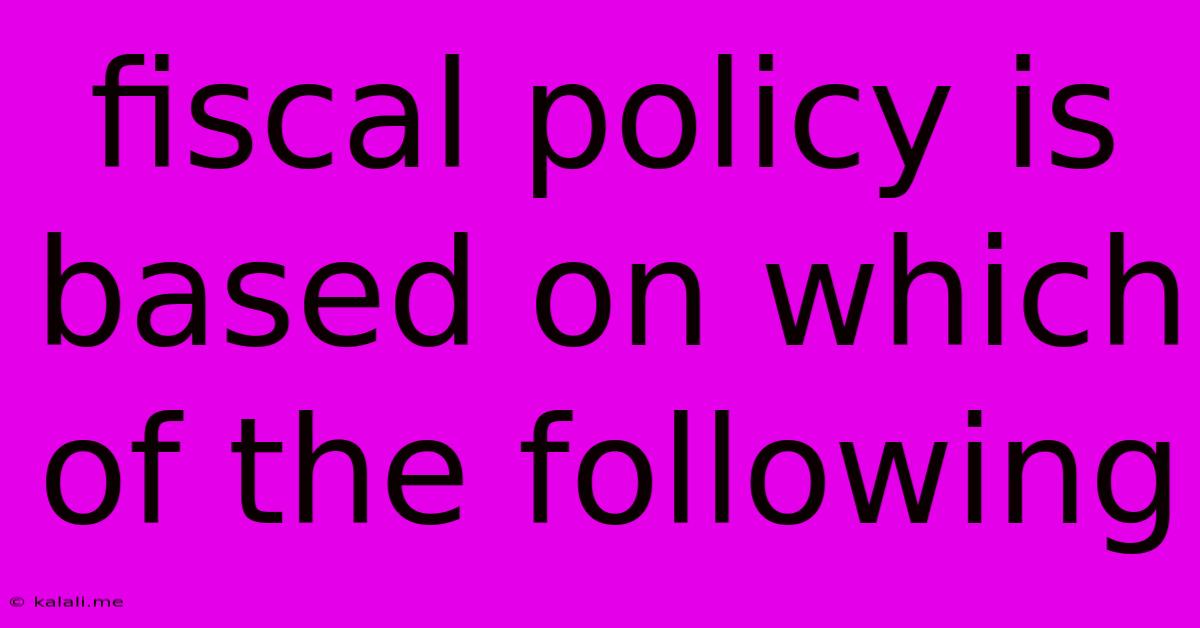Fiscal Policy Is Based On Which Of The Following
Kalali
Jun 15, 2025 · 3 min read

Table of Contents
Fiscal Policy: A Foundation Built on Government Spending and Taxation
Fiscal policy, a cornerstone of macroeconomic management, is the use of government spending and taxation to influence the economy. Understanding its foundations is crucial for grasping its impact on economic growth, inflation, and employment. This article will delve into the core principles upon which fiscal policy is based.
Meta Description: Explore the fundamental principles underpinning fiscal policy: government spending and taxation's role in influencing economic activity, and the different approaches used to achieve macroeconomic goals.
The Two Pillars of Fiscal Policy: Government Spending and Taxation
At its heart, fiscal policy rests on two powerful levers:
-
Government Spending: This encompasses all expenditures undertaken by the government at all levels (federal, state, and local). This includes infrastructure projects (roads, bridges, schools), social welfare programs (unemployment benefits, social security), defense spending, and salaries for public sector employees. Increased government spending injects money into the economy, stimulating demand and boosting economic activity. This is often used during economic downturns to stimulate growth, a concept known as expansionary fiscal policy.
-
Taxation: This involves the collection of revenue by the government from various sources, including income tax, corporate tax, sales tax, and property tax. Taxation acts as a mechanism to finance government spending and to manage aggregate demand. Higher taxes reduce disposable income, potentially dampening consumer spending and inflation. Conversely, tax cuts increase disposable income, encouraging spending and investment, a cornerstone of expansionary fiscal policy.
Key Objectives of Fiscal Policy
Fiscal policy isn't implemented randomly; it's strategically designed to achieve specific macroeconomic goals, including:
-
Economic Growth: Stimulating economic growth through strategic spending on infrastructure, research and development, and education is a primary objective. Tax incentives for businesses can also encourage investment and expansion.
-
Full Employment: Fiscal policy aims to maintain a low unemployment rate. Expansionary fiscal policy during recessions can create jobs through government projects and stimulate private sector hiring.
-
Price Stability: Managing inflation is another critical goal. Contractionary fiscal policy (reducing government spending and/or raising taxes) can help curb inflation by reducing aggregate demand.
-
Income Redistribution: Progressive tax systems, where higher earners pay a larger percentage of their income in taxes, aim to redistribute wealth and reduce income inequality. Social welfare programs also contribute to this objective.
-
Debt Management: Governments must carefully manage their debt levels. Fiscal policy decisions must balance the need for economic stimulus with the long-term sustainability of public finances. Excessive government debt can have negative consequences for economic stability.
Different Approaches to Fiscal Policy
The specific approach to fiscal policy can vary depending on the prevailing economic conditions and the government's priorities. Two main approaches exist:
-
Discretionary Fiscal Policy: This involves deliberate changes in government spending and taxation enacted by the legislature. Examples include passing a new infrastructure bill or implementing a tax cut. This approach requires political consensus and can be slow to implement.
-
Automatic Stabilizers: These are built-in mechanisms that automatically adjust government spending and taxation in response to economic fluctuations. Examples include unemployment benefits (which rise during recessions) and progressive tax systems (which automatically collect more revenue during economic booms). Automatic stabilizers provide a more immediate and predictable response to economic shocks.
Conclusion
Fiscal policy, based on the interplay of government spending and taxation, is a powerful tool for influencing macroeconomic conditions. Understanding its core principles, objectives, and approaches is essential for evaluating its effectiveness and impact on the overall economy. The judicious application of fiscal policy can be instrumental in achieving sustainable economic growth, full employment, price stability, and a fairer distribution of income.
Latest Posts
Latest Posts
-
What Is The Lcm Of 36 And 18
Jun 15, 2025
-
Which Of The Following Is Not A Pure Substance
Jun 15, 2025
-
How Many Elements Occur Naturally On Earth
Jun 15, 2025
-
The Panama Canal Connects To What Two Bodies Of Water
Jun 15, 2025
-
Find The Cubic Function With The Given Zeros
Jun 15, 2025
Related Post
Thank you for visiting our website which covers about Fiscal Policy Is Based On Which Of The Following . We hope the information provided has been useful to you. Feel free to contact us if you have any questions or need further assistance. See you next time and don't miss to bookmark.